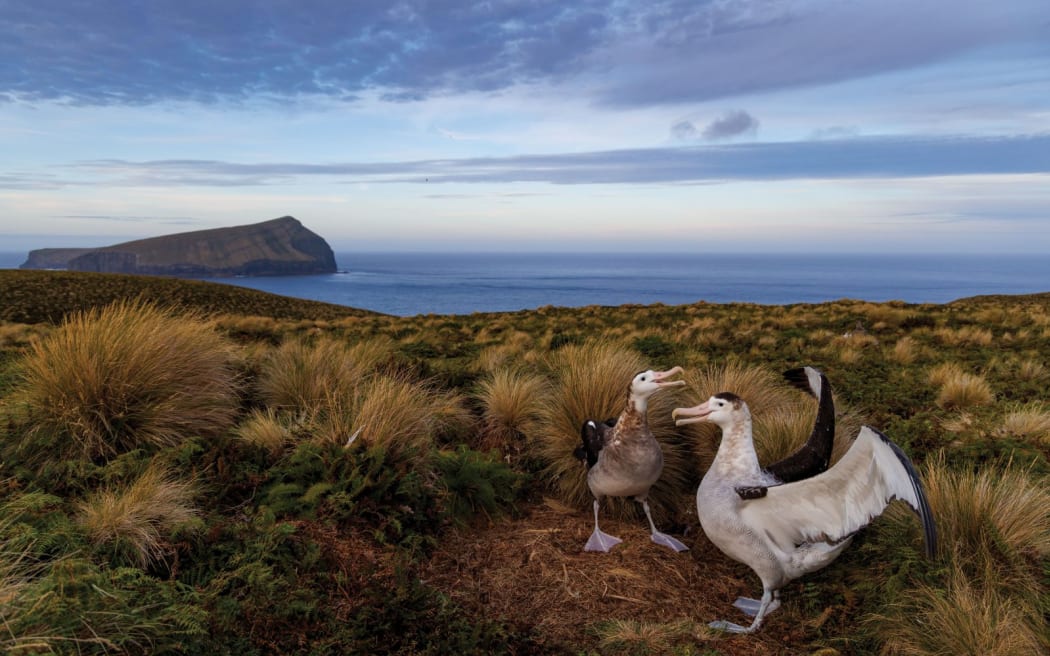
Richard Robinson encountered these Antipodean albatrosses socialising on an empty nest, “making a hell of a lot of noise”. The albatross on the right is part of the mark-recapture study. He received his leg band as a chick in 2002, and lived at sea for several years before returning to Antipodes Island in 2010. He was spotted courting a female albatross in 2012 and 2013, and the pair made it official in 2014, raising a chick together. But his mate hasn’t been seen again since, and he’s been hanging around for close to a decade now without a partner. Photo: © Richard Robinson
Follow Voice of Tangaroa on Apple Podcasts, Spotify, iHeart or wherever you get your podcasts
Gibson’s and Antipodean albatrosses are citizens of no one nation. They are ocean birds, living on the wind and waves, travelling massive distances, passing back and forth over the high seas and the imaginary boundary lines we draw on maps.
But when they land to chat, to flirt, to lay an egg and raise a chick, they come to two of New Zealand’s subantarctic islands.
Three decades of albatross study
And when they return, some of them meet with two familiar human faces.
Across the last 34 years, Department of Conservation researchers Kath Walker and Graeme Elliott have been visiting these islands to count the birds, and to study them.
At first everything seemed fine. In the early 1990s numbers were low but increasing. Things were positive. Then came the summer of 2006/2007. There was a population crash, reason still unknown, and on both islands, albatross numbers plummeted.
These albatrosses don’t breed until they at least eight-years-old, only breed every two years, and tend to mate for life. Since the crash, Gibson’s albatross numbers have come back slightly, but Antipodean albatross numbers continue to decline.
And adult birds, especially females, are still going missing.
Hooks don’t discriminate
Tuna fishing boats use a method called surface longlining to catch their prey. The lines can be up to 100 kilometres long, with thousands of hooks.
Squid is used as bait, a tasty morsel for tuna. Unfortunately, albatrosses agree.
Using satellite tags Graeme and Kath have watched missing albatrosses’ paths overlap with those of boats, and in one case, in which leg bands and the satellite tag were returned to them, follow the path of the boat.
Listen as science journalist Rebekah White explores the albatross bycatch problem, and what we could do about it.

This juvenile albatross was hooked by a Japanese tuna longliner east of Tasmania. The man cradling the bird – to demonstrate its size – is a crew member of an Australian patrol vessel. Photo: Graham Robertson
Learn more:
-
Read the accompanying New Zealand Geographic article by Rebekah White, with photography by Richard Robinson.
-
Listen to previous episodes of Voice of Tangaroa.
-
Our Changing World has previously interviewed Kath and Graeme about their research: in 2013 and 2009.
-
Learn more about where these albatrosses breed from Our Changing World episodes about the Antipodes Islands, and the Auckland Islands.

Photo: NZ On Air
Voice of Tangaroa is a joint production between RNZ’s Our Changing World and New Zealand Geographic.
Reporting for this series is Public Interest Journalism funded through NZ On Air. You can learn more and read the articles for free at www.nzgeo.com/seas. Live Ocean Foundation supported some of the travel costs for this story.

